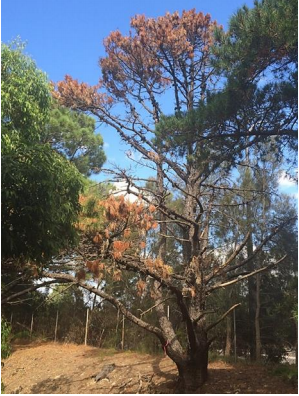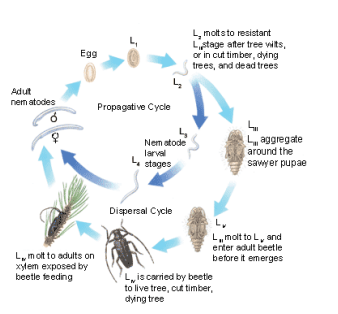
Pine nematodes
| Primefact number | Edition | Published | Author |
|---|---|---|---|
| 1466 | First | May 2016 | Plant Biosecurity and Product Integrity |
Pine nematodes include nematodes of the genus Bursaphelenchus. Some species of this genus are exotic plant pests not present in Australia. These nematodes are a serious threat to Australia’s forestry industry.
If found they must be reported promptly by one of the following methods:
- Call the Exotic Plant Pest Hotline 1800 084 881
- Email biosecurity@dpi.nsw.gov.au with a clear photo and your contact details
- Complete an online form
A full list of notifiable plant pests and diseases can be found in Schedule 2 of the NSW Biosecurity Act 2015.
Description
Pine nematodes are microscopic, wormlike organisms. They are invisible to the naked eye and require technical expertise and molecular methods for identification.
How to spot a tree infested with pine nematode
The first symptoms of a pine nematode infestation include brown and dry needles in the tree branches.
Tree death usually progresses from the top of the tree downward.
A serious nematode infestation can result in rapid dieback of the pine tree, sometimes within a few weeks.
Many pine trees normally have dead needles present in the canopy and the odd dead branch. It is considered relatively normal for up to 15% of the tree canopy to be affected by dead tips or dead older needles caused by environmental factors other than nematodes. Suspected nematode presence needs to be confirmed by a technical expert.
Pine nematodes
The Bursaphelenchus genus contains more than 100 species of nematodes. These nematodes are often associated with dead or dying conifer trees, mostly pine (Pinus species).
Most species of Bursaphelenchus feed on fungi and don’t cause direct damage to the host tree. However, there are a few species in the genus that are known to feed on plant cells. In these cases, damage caused by pine nematodes can lead to rapid tree wilt and death.
Damage
Pine nematodes move through infested host trees in the water transport system. Nematodes feeding on plant cells cause air pockets to form, disrupting water uptake by the tree. Death of the tree is rapid, often within a few weeks or months.
Spread
Most pine nematodes are carried from infested trees to new host trees by vector beetles. A number of beetle species belonging to the Scolytidae, Cerambycidae, Curculionidae, and Buprestidae families are known to vector pine nematodes.
Pine nematodes and their beetle vectors can be spread over long distances with the transport of conifer wood chips, logs, unseasoned timber, untreated wooden pallets, crates, packing-case material and dunnage.
Lifecycle
The pine nematode has two lifecycles: one completed inside the host tree and one inside the vector beetle (Figure 2).
In the host tree, the lifecycle occurs in the sapwood and involves the egg, four larval stages and the adult. A complete cycle can take only 4−5 days under favourable conditions.
Infestation of the vector beetle occurs after tree death. Nematode larvae infest beetle pupae present in the tree and undergo a non-feeding larval stage for transport. These larvae enter the respiratory system of the young beetle when it emerges and are vectored by the beetle to new host trees.
Hosts
Of over 100 known species of Bursaphelenchus approximately 70% are associated with conifers, mainly pines (Pinus species). Common trees in Australia known to be hosts of Bursaphelenchus nematodes include:
- Aleppo pine (Pinus halepensis)
- Austrian pine (Pinus nigra)
- Common spruce (Picea abies)
- Maritime pine (Pinus pinaster)
- Ponderosa pine (Pinus ponderosa)
- Radiata pine (Pinus radiata)
- Stone pine (Pinus pinea)
- Scots pine (Pinus sylvestris)
- Turkish pine (Pinus brutia)
Distribution
Bursaphelenchus nematodes are found in the Mediterranean countries of Turkey, Greece, Spain, Italy, France, Portugal, the Asian countries of Japan, South Korea, Taiwan and China as well as the USA, Mexico and Canada.
Management
Control of pinewood nematode is limited to prevention. Chemical control is impractical, expensive and ineffective.
Infested trees should be removed. Dead trees, including the stump, should be burned or buried as soon as possible.
Reporting
If you suspect pine nematodes:
- Call the Exotic Plant Pest Hotline on 1800 084 881
- Take photos not samples to minimise the risk of spreading this pest
- Email clear photos with a brief explanation and contact details to biosecurity@dpi.nsw.gov.au
Acknowledgments
Figure 1. courtesy of Angus Carnegie, NSW DPIRD
Figure 2. courtesy of Hanson and Cram 2004, Northeastern Area State & Private Forestery USDA Forest Service



